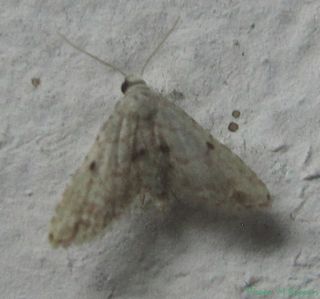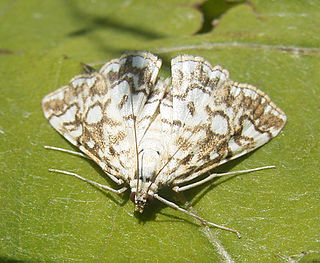| Araeomorpha | |
|---|---|
| Scientific classification | |
| Kingdom: | Animalia |
| Phylum: | Arthropoda |
| Class: | Insecta |
| Order: | Lepidoptera |
| Family: | Crambidae |
| Subfamily: | Acentropinae |
| Genus: | Araeomorpha Turner, 1908 [1] |
| Synonyms | |
| |
| Araeomorpha | |
|---|---|
| Scientific classification | |
| Kingdom: | Animalia |
| Phylum: | Arthropoda |
| Class: | Insecta |
| Order: | Lepidoptera |
| Family: | Crambidae |
| Subfamily: | Acentropinae |
| Genus: | Araeomorpha Turner, 1908 [1] |
| Synonyms | |
| |

Dorothy Hill, AC, CBE, FAA, FRS was an Australian geologist and palaeontologist, the first female professor at an Australian university, and the first female president of the Australian Academy of Science.
Arthromastix is a genus of moths of the family Crambidae. It contains only one species, Arthromastix lauralis, which is found in Central America, South America, as well as the Dominican Republic and Cuba.

Araeopteron is a genus of moths of the family Erebidae. The genus was erected by George Hampson in 1893.
Abantiades aphenges is a moth of the family Hepialidae. It is endemic to Australia, including New South Wales and Queensland.

Acentropinae is a fairly small subfamily of the lepidopteran family Crambidae, the crambid snout moths. Species of this subfamily are exclusively found in wetlands and aquatic habitats.
Gymnoscelis spodias is a moth in the family Geometridae. It was described by Alfred Jefferis Turner in 1922. It is found in Australia (Queensland).
Araeomorpha diplopa is a moth in the family Crambidae. It is found in Australia, where it has been recorded from New South Wales and Queensland.
Trigonoorda rhodea is a moth in the family Crambidae. It was described by Oswald Bertram Lower in 1905. It is found in Australia, where it has been recorded from Queensland and the Northern Territory.
Trigonoorda rhodopa is a moth in the family Crambidae. It was described by Alfred Jefferis Turner in 1908. It is found in Australia, where it has been recorded from Queensland and the Northern Territory.
Archernis argocephala is a moth in the family Crambidae. It was described by Oswald Bertram Lower in 1903. It is found in Australia, where it has been recorded Queensland.
Hileithia invidiosa is a moth in the family Crambidae. It was described by Harrison Gray Dyar Jr. in 1914. It is found in Panama.

Metallarcha thiophara is a moth in the family Crambidae. It was described by Turner in 1917. It is found in Australia, where it has been recorded from Western Australia.
Metasia phragmatias is a moth in the family Crambidae. It was described by Oswald Bertram Lower in 1903. It is found in Australia, where it has been recorded from Queensland.
Pygospila hyalotypa is a moth in the family Crambidae. It was described by Turner in 1908. It is found in Papua New Guinea and Australia, where it has been recorded from Queensland.
Sedenia achroa is a moth in the family Crambidae described by Oswald Bertram Lower in 1902. It is found in Australia, where it has been recorded from Western Australia.
Prionocris rhodopepla is a moth in the family Oecophoridae. It was described by Oswald Bertram Lower in 1903. It is found in Australia, where it has been recorded from Queensland.
Illidgea is a genus of moths of the family Xyloryctidae.
Illidgea epigramma is a moth in the family Xyloryctidae. It was described by Edward Meyrick in 1890. It is found in Australia, where it has been recorded from the Australian Capital Territory, New South Wales, Queensland and South Australia.
Imma lichneopa is a moth in the family Immidae. It was described by Oswald Bertram Lower in 1903. It is found in Australia, where it has been recorded from Queensland.
Imma stilbiota is a moth in the family Immidae. It was described by Oswald Bertram Lower in 1903. It is found in Australia, where it has been recorded from Queensland.
| This Acentropinae-related article is a stub. You can help Wikipedia by expanding it. |